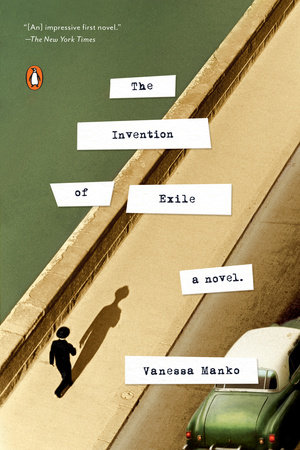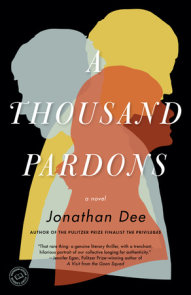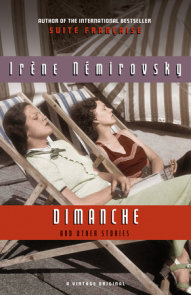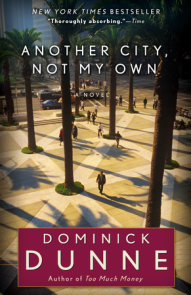READERS GUIDE
Questions and Topics for Discussion
INTRODUCTION
Austin Voronkov is many things. He is an engineer, an inventor, an immigrant from Russia to Bridgeport, Connecticut, in 1913, where he gets a job at a rifle factory. At the house where he rents a room, he falls in love with a woman named Julia, who becomes his wife and the mother of his three children. When Austin is wrongly accused of attending anarchist gatherings his limited grasp of English condemns him to his fate as a deportee, retreating with his new bride to his home in Russia, where he and his young family become embroiled in the Civil War and must flee once again, to Mexico.
While Julia and the children are eventually able to return to the U.S., Austin becomes indefinitely stranded in Mexico City because of the black mark on his record. He keeps a daily correspondence with Julia, as they each exchange their hopes and fears for the future, and as they struggle to remain a family across a distance of two countries. Austin becomes convinced that his engineering designs will be awarded patents, thereby paving the way for the government to approve his return and award his long sought-after American citizenship. At the same time he becomes convinced that an FBI agent is monitoring his every move, with the intent of blocking any possible return to the United States.
Austin and Julia’s struggles build to crisis and heartrending resolution in this dazzling, sweeping debut. The novel is based in part on Vanessa Manko’s family history and the life of a grandfather she never knew. Manko used this history as a jumping off point for the novel, which focuses on borders between the past and present, sanity and madness, while the very real U.S.-Mexico border looms. The novel also explores how loss reshapes and transforms lives. It is a deeply moving testament to the enduring power of family and the meaning of home.
ABOUT VANESSA MANKO
Vanessa Manko earned her MFA in creative writing from Hunter College. She has taught writing at NYU and SUNY Purchase. An excerpt of her novel was published in Granta‘s winter 2012 issue. Originally from Brookfield, Connecticut, Manko now lives in Brooklyn, New York.
A CONVERSATION WITH VANESSA MANKO
What compelled you to write this book?
The novel is partly inspired by family history and focuses on the life of a grandfather I never knew. The true story came to me in bits and pieces throughout my childhood but was rarely discussed. I grew up believing that my grandmother just didn’t have a husband, and then of course I figured out that that couldn’t be the case and began asking questions. I became increasingly interested in Russian history, culture, and literature, and as I pieced together the historical and cultural context of my grandfather’s life, I grew curious about the man himself. Who was he exactly? How did he think? What were his hopes and dreams, and, most important, what were his days like, living alone in Mexico City, separated from family, language, culture, and country? I became obsessed with discovering and inventing his character as a way to shade in the space of his absence from our lives, and from the life of my father, who grew up without him. Of course, the novel took on a life of its own, but a big reason I wanted to write this book was to find out who my grandfather was and what happened to him.
Austin is wrongly accused of being an anarchist and is deported as a result of the Palmer Raids. Tell us about the Palmer Raids and what you learned while researching for the book. Why do you think this chapter in American history isn’t well known?
The Palmer Raids were a series of raids organized by Attorney General A. Mitchell Palmer in 1919 and 1920. They were devised in response to the growing fear and widespread paranoia that the Russian Revolution and Bolshevik ideology were spreading to the United States and that Reds and radicals and anarchists were plotting to overthrow the U.S. government by force. According to Palmer, members of these subversive groups needed to be identified and found, arrested, and expelled from the country. Together with J. Edgar Hoover, the chief of the Radical Division in the Bureau of Investigation (the precursor to the FBI), Palmer targeted Russian immigrant organizations such as social clubs, church groups, benevolent aid societies, and labor unions—any organization or institution with supposed communist, or Red, sympathies.
As I conducted research, I learned that it was during this time that Hoover began his infamous index card filing system as a way to keep tabs on individuals and organizations deemed a threat to the American way of life. The index cards noted occupation, residence, associations, and what organizations an individual belonged to or what newspapers and magazines he or she read or subscribed to—basically, any evidence that could be used to prove ties to Red or anarchist ideology. The raids themselves took place over a series of evenings from late 1919 into January 1920. Federal agents and police broke into union meetings, social clubs, benevolent aid societies, churches, and night-school classes. They rounded up and arrested several Russian immigrants, who were then detained, interrogated, and, in some cases, deported from the country. This is precisely what happens to Austin in the novel. We now know that the Palmer Raids infringed on civil liberties, breaking the First, Fourth, Fifth, and Eighth Amendments.
I think this is a little-known chapter in American history because it is a shameful one. It’s difficult to acknowledge because it’s so at odds with intrinsic American values. Also, we are a nation of immigrants and one that prides itself on accepting newcomers who want to build better lives here. At the same time, we have a long history of keeping (and kicking) people out, and this isn’t an easy contradiction to face or to contemplate.
Austin’s return to Russia, with Julia beside him, seems almost surreal. The reader, along with Austin, almost cannot believe he’s there. Can you talk about what was happening in Russia at the time? Why did Austin leave in the first place?
Austin and Julia return to Russia during the country’s civil war, when the Whites (anti-Bolsheviks) are fighting the Reds (pro-Bolsheviks). It’s a time of mass hardship, with food and wood shortages; it’s also very cold and an extremely dangerous place to be, especially if you’ve just returned from America. My aim was to convey to the reader the same sense of disbelief and dislocation that Austin and Julia might have felt when returning to Russia in the midst of such chaos, and how such larger political forces can come to bear on, and wreak havoc with, the lives of these two young people simply hoping to build a life together.
Austin came to the United States in 1913 in order to work as an engineer in a rifle factory that made arms for the Russian Imperial Army. Many Russian engineers were recruited for this line of work. He also has his own ambitions and it is in America that he feels he can realize his dreams of becoming a successful inventor, an enduring hope and ambition that eventually becomes his life-long obsession.
The novel shifts back and forth in time and place—from the United States, to Russia, to Paris, to Mexico—and alternates perspectives, to great effect. Why did you choose this format?
I first had an image in my mind of this lone figure walking around Mexico City, silent and absorbed in a world of his own. I wanted to follow him. What happened to him? What is his story? I thought too about how we learn someone’s story—it doesn’t come all at once but in fragments and over time. I wanted readers to see Austin through his lived experiences and how they have affected his current state.
The novel isn’t linear and straightforward; I presented him one way in Mexico City, 1948, as older and broken, and a little lost, and another way as a young Russian immigrant in the United States, filled with hope and pride and ambition. I wanted to follow him throughout his travels and hardships, eventually allowing the reader to piece together his life and come to understand why he ends up the way that he does. As the novel also deals with a family that has been torn apart, my aim was for this structure to underscore and mirror the disparate life of a refugee family.
I also feel the structure is similar to the workings of Austin’s broken mind. And because his is an isolated and obsessive point of view, I knew that in order to broaden the novel’s perspective, I’d need to bring in other voices. I wanted to see Austin through the eyes of the women in his life. There’s Julia, Austin’s wife, who represents the past and is synonymous with his dream and vision of an American life. Anarose in Mexico is important because she draws him out of his lonely existence in exile and offers a glimmer of what it might be to “invent” a different life in Mexico City. And there’s Vera, who, to me, is symbolic of American pragmatism; she’s realistic and straightforward and in direct contrast to her old-world, downtrodden father. Like the countries—the United States, Mexico, Russia—the women in the novel are forces in his life. In fact, I think they are the most active characters in the novel.
Throughout his agonizing wait, Austin must reconsider time and again what it means to be an American. Can you talk about his thought process?
Austin’s determination to return to his family in the United States is tied to his desperate desire to gain his American citizenship. Although Austin is a stateless individual living in exile, I feel that in some ways he is a very “American” character. In fact, he has all the qualities we associate with being just that: he possesses ambition and fortitude; he is preoccupied with success and building a name for himself; he is desperate to raise a family, own a house, and have a garden. As his hopes to reenter the United States dwindle, he is plunged into self-doubt and uncertainty and begins to question his ambitions and identity as fiercely as he holds on to the hope that his inventions will bring him to America. His thoughts about American citizenship and identity shift and become larger, existential questions about life, as he now lives beyond the perimeters of any nationality. He is not an American; only an “applicant” for American citizenship. Neither is he a citizen of Russia, because the country no longer exists; it’s now the Soviet Union. Likewise, he has no rights as a Mexican citizen. Meanwhile, he has complex, contradictory thoughts about what it means to be an American. It is something he desperately wants, but he is also angry, and rightly so—for America is the country whose government deported him and whose politics will not allow him to reenter.
The construction and conception of borders—geographical, temporal, and psychic— reemerge throughout the novel. How do borders both divide and connect us?
In addition to a man alone in Mexico City, I also worked with the image of a man standing before a (then more open) border who is unable to cross it. Why can he not cross the border? That became a central question in the book and I had to write it to explain why. It haunted me, really—how to make it believable and dramatize the psychology behind such action, or inaction. As I wrote the novel and saw how it would move back and forth in time, I realized that the border between the past and present was just as important thematically as the borders between countries. And, of course, it’s also about the borders in our minds—more specifically, in Austin’s mind, and the imaginary lines he’s unable to cross in his life: his inability to cross the border illegally and return to the United States and his family, his inability to step into his present existence and live and build a life in Mexico City, and also the fine line between reality and his more paranoid experiences.
I love the paradox intrinsic to lines and boundaries or any kinds of demarcations that seem to separate, because in fact these are also places that join or connect. For instance, Austin and Julia choose to go to Mexico both because it’s a country that will accept them and because, to quote from the novel, “it’s the closest place to home.” The lines between the past and present also connect and divide. Time is how we delineate certain phases of our lives, but the past is tied to, and exists in, the present. We are the culmination of our particular experiences. Likewise, the borders between states of mind divide and connect. Austin, for instance, goes back and forth across the border of sanity and madness. He is living sometimes in reality, sometimes within his imagination and paranoid fears. I wanted the reader to question his hold on reality. I also can’t help but think about the borders between truth and fiction, because while this novel is inspired by a true story, it is an invention that has brought this character—and a version of my grandfather’s story—across time and place to connect with the reader.
The novel is in part inspired by your family’s story and your grandfather’s life in particular. Can you talk about learning about his story and how you see him in Austin?
Yes. Austin Voronkov is based on my grandfather’s life—my father’s father, whom I never knew. And for the most part his story was hidden, or, at least, not talked about. I like to say my father came from “the generation of secrets.” He rarely spoke about his father, and when he did, it was just fragments of the story—very little about the man himself. I grew curious about who my grandfather might have been, what happened to him, and how it must have been for him to live a life alone in Mexico City. As I pieced together the story, I saw its potential for a novel and I began to imagine his character, an engineer-inventor living in exile and longing for his family. It was difficult material to sort through because, although I was writing fiction, the story was also deeply personal. I found myself examining a family legacy of deportation, fear of government and paranoia, dislocation and powerlessness. In some ways, I hope the novel helps to redeem my grandfather even though I’ve made him into a fictional character. Of course, I can never really know if the fictional Austin is the real-life Austin, but it is my hope that they share similarities.
What does the title mean to you?
The novel follows the story of an inventor living in exile, but the title works on a deeper level as well. Living alone in Mexico City, cobbling together an existence by working in a repair shop, haunted by the past and consumed with his inventions, Austin lives in a world of his own, cut off from others. He is unable to really step into a life and an existence there, and yet he cannot cross the border into the United States—a border that was more permeable during the time of this novel than it is now. In many ways his exile is just as much an element of his imagination as any of the inventions he believes will take him out of his exiled state. In short, he has invented his own exile.
DISCUSSION QUESTIONS
- What are your definitions of home and family? What are Austin’s? How do your definitions align or differ?
- What was your reaction to the interrogation scenes in Connecticut (pp. 20–37)? Do you think there was anything Austin could have done to sway the inquisitor’s mind?
- How is the lighthouse symbolic in Austin’s and Julia’s lives? What about Julia’s flooded garden?
- Austin is very hopeful, to the point of obsession, that his inventions will aid him in reuniting with his family. How does the theme of invention work in his life and in the novel?
- What is Anarose’s role?
- The storyline and perspective shift and jump over time and place. How does this structure inform the story?
- Austin muses, “Paper is stronger than one thinks. Papers, documents don’t define a man, but they lived in a mire of them. . . . His days revolved around papers. But no amount of paper means a country” (p. 116). What do you think about this passage? How do papers control how Austin conducts his life?
- How does Austin’s story fit into the trope of the United States as a “melting pot” for immigrants? How did it influence your thoughts on the immigrant experience?
- Austin is paranoid that an FBI agent, Jack, has him under surveillance. Do you think the agent is real, or is he a figment born of fear and distrust? What purpose does Jack serve?
- Correspondence is a vital undercurrent in Austin’s life. How do the many letters and notes we read bring him closer to—and push him further apart from—his loved ones? How do you correspond with people close to you?
- How does Austin’s conception and understanding of being American and returning to the United States change throughout the novel? What was your reaction to his thoughts in the final pages?
- What does the title, The Invention of Exile, mean to you? In what ways was Austin in exile?




















